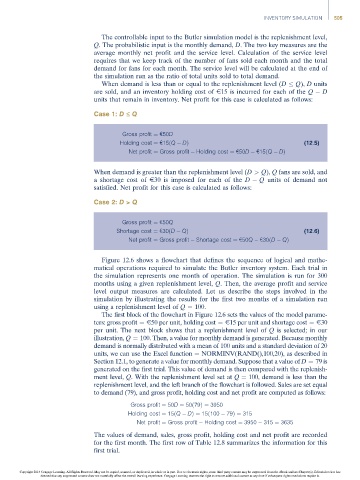Page 525 -
P. 525
INVENTORY SIMULATION 505
The controllable input to the Butler simulation model is the replenishment level,
Q. The probabilistic input is the monthly demand, D. The two key measures are the
average monthly net profit and the service level. Calculation of the service level
requires that we keep track of the number of fans sold each month and the total
demand for fans for each month. The service level will be calculated at the end of
the simulation run as the ratio of total units sold to total demand.
When demand is less than or equal to the replenishment level (D Q), D units
are sold, and an inventory holding cost of E15 is incurred for each of the Q D
units that remain in inventory. Net profit for this case is calculated as follows:
Case 1: D £ Q
Gross profit ¼ e50D
Holding cost ¼ e15ðQ DÞ (12:5)
Net profit ¼ Gross profit Holding cost ¼ e50D e15ðQ DÞ
When demand is greater than the replenishment level (D > Q), Q fans are sold, and
a shortage cost of E30 is imposed for each of the D Q units of demand not
satisfied. Net profit for this case is calculated as follows:
Case 2: D > Q
Gross profit ¼ e50Q
Shortage cost ¼ e30ðD QÞ (12:6)
Net profit ¼ Gross profit Shortage cost ¼ e50Q e30ðD QÞ
Figure 12.6 shows a flowchart that defines the sequence of logical and mathe-
matical operations required to simulate the Butler inventory system. Each trial in
the simulation represents one month of operation. The simulation is run for 300
months using a given replenishment level, Q. Then, the average profit and service
level output measures are calculated. Let us describe the steps involved in the
simulation by illustrating the results for the first two months of a simulation run
using a replenishment level of Q ¼ 100.
The first block of the flowchart in Figure 12.6 sets the values of the model parame-
ters: gross profit ¼ E50 per unit, holding cost ¼ E15 per unit and shortage cost ¼ E30
per unit. The next block shows that a replenishment level of Q is selected; in our
illustration, Q ¼ 100. Then, a value for monthly demand is generated. Because monthly
demand is normally distributed with a mean of 100 units and a standard deviation of 20
units, we can use the Excel function ¼ NORMINV(RAND(),100,20), as described in
Section 12.1, to generate a value for monthly demand. Suppose that a value of D ¼ 79 is
generated on the first trial. This value of demandisthencomparedwith thereplenish-
ment level, Q. With the replenishment level set at Q ¼ 100, demand is less than the
replenishment level, and the left branch of the flowchart is followed. Sales are set equal
to demand (79), and gross profit, holding cost and net profit are computed as follows:
Gross profit ¼ 50D ¼ 50ð79Þ¼ 3950
Holding cost ¼ 15ðQ DÞ¼ 15ð100 79Þ¼ 315
Net profit ¼ Gross profit Holding cost ¼ 3950 315 ¼ 3635
The values of demand, sales, gross profit, holding cost and net profit are recorded
for the first month. The first row of Table 12.8 summarizes the information for this
first trial.
Copyright 2014 Cengage Learning. All Rights Reserved. May not be copied, scanned, or duplicated, in whole or in part. Due to electronic rights, some third party content may be suppressed from the eBook and/or eChapter(s). Editorial review has
deemed that any suppressed content does not materially affect the overall learning experience. Cengage Learning reserves the right to remove additional content at any time if subsequent rights restrictions require it.

